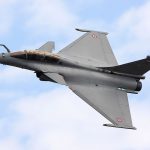Serbian President Aleksandar Vucic has declared his state’s intention of buying the Rafale jet fighter from France’s Dassault Aviation. The announcement – produced whilst Vucic was on a two-day take a look at to France – observed that a firm agreement signing is predicted in two months.
The declaration of a French fighter purchase underlines Serbia’s intention to diversify its sources of army importation, while underlining the fallout for Russian protection exports in the wake of its invasion of Ukraine.
Serbia inherited much of its armed forces stock from the previous Yugoslav Republic, which all through the Cold War associated locally produced hardware supplemented extensively by significant-end techniques supplied from the former Soviet Union. With the demise of the latter coupled by the breakup for the previous Yugoslavia, Serbia was still left with more mature techniques necessitating substantial Russian support in the variety of spare pieces and updates, moreover the occasional donation of surplus beat aircraft these types of as six MiG-29s transferred from Russia in Oct 2017.
With Serbia historically aligning much more closely with Moscow and sustaining a level of detachment from NATO (for obvious causes: see the 1999 Kosovo War) the total military inventory of the Serbian armed forces remained seriously tilted towards Russian-made units.
But in just the earlier decade indicators began to look that Serbia was fascinated in attaining non-Russian techniques as it little by little commenced upgrading its eroding armed forces abilities.
A very first phase in the work to diversify its armed forces aviation systems transpired on December 28, 2016, when Serbia agreed to procure nine H145M twin-engine multirole helicopters from Airbus (4 of these have been allotted to the Ministry of Interior).
This was adopted by acquisition of unmanned aerial motor vehicles (UAVs) from China’s state-owned China Aerospace Science and Technological know-how Company (CASC) Rainbow household of drones. These concerned CH-92A armed reconnaissance drones and CH-95 extensive-variety strike UAVs obtained from 2020 onwards.
Then, in February 2022, Serbia inked a €81 million governing administration-to-authorities arrangement with Spain for a pair of Airbus C-295 military transport aircraft.
Now, with Russia’s defense marketplace centered foremost on supporting the nation’s stalemated invasion of Ukraine and the Moscow subject matter to trade and financial sanctions and Western export controls, Russian systems no for a longer time current a palatable different for Serbia by the small-term.
A Rafale purchase will deliver the first Western-built fighter functionality into the Serbian Air Pressure’s fleet, which at this time is composed of legacy Yugoslav J-22 floor assault plane and Russian-produced MiG-29s.
Perhaps equally intriguing, Serbia opted for a combat plane acquired by neighboring Croatia, with whom Belgrade has lengthy experienced an uneasy romantic relationship.
At a distinct stage, Serbia’s announcement of a Rafale procurement provides to the expanding achievements of gross sales of that individual fighter in the rapid region. There were the next-hand Rafales had been ordered by Croatia in November 2021, as effectively as 24 units acquired by Greece in two batches (18 of combined new-build and made use of models in January 2021, moreover six new added units in March 2022).
On the flip aspect, Russia is seeing one particular of its conventional armed forces export marketplaces commence to gradually slip from its grasp.
The concentration of sector exertion to providing Russian forces in Ukraine erodes export probable by consuming most new production components and drawing absent from right after-profits guidance to foreign marketplaces, specifically as spare parts are shifted to the Ukrainian front alternatively than to current purchasers.
The menace of the U.S. CAATSA (Countering The usa’s Adversaries By Sanctions Act) sanctions routine resulting in becoming barred from paying for American-sourced army components also looms above some of Russia’s conventional purchasers. Though Serbia is disinclined to be involved about CAATSA sanctions, others – these types of as Indonesia – have backed absent from prior commitments on Russian devices buys and alternatively opted for options (in Indonesia’s case it also made a decision upon the Rafale to satisfy a vacated Su-35 purchase need).
As a result the Serbian choice to choose for the Rafale implies two issues: 1) A Serbian choice to diversify its hardware devices absent from one-source dependence, and 2) Russia’s world-wide arms sale sector share carries on to ebb given that Moscow launched its invasion of Ukraine in February 2022.
